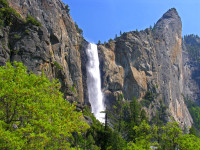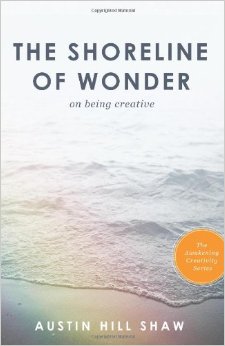by Melanie Davis
I have recently taken a walk along the dynamic, flowing banks of creativity by reading Austin Hill Shaw’s The Shoreline of Wonder. It was not a jog or a run, but a meditative stroll through the pages of Shaw’s captivating tome, which is part of his expanded The Awakening Creativity Series. Shaw has designed it so you won’t turn the pages quickly; you’ll want to stop and re-read ideas and concepts which are both fresh and challenging.
To pull from Shaw’s own explanation, “The Shoreline of Wonder is a guide to understand, explore and activate two fundamental aspects of creativity- the Ground and the Path- in your own experience of living.” Indeed, reading Shaw’s book is a journey of discovery and understanding with earthy and celestial metaphors that expand your concept of creativity far beyond the traditional boundaries, suggesting that existence itself is the core of creative expression.

Bridalveil Fall
I was pulled into Shaw’s characterization of creativity immediately, when in the introduction he writes about his experience of rock climbing in Yosemite National Park. Cresting the 800-foot pillar known as the Rostrum, Shaw looked across towards the South Rim at the magnificent Bridalveil Fall. As his gaze lingered on the 620-foot waterfall while waiting for his friend to complete his ascent, Shaw witnessed it morph from red to orange to yellow and all the hues in between. The sun had struck the massive rush of water droplets, creating an extraordinary show of light and color as it set lower in the sky. The awe of those few minutes sent his thoughts reeling through time and space as Shaw considered the complexity of elements coming together for that moment’s grandeur.
In his book, Shaw debunks common myths that suggest only people of talent possess creative ability, or that creativity is inherent in certain activities, such as art and music, and not in others, such as science and engineering. At one point in The Shoreline of Wonder, Shaw shares how he has come to recognize that our desire to create comes from the same impetus from which various religions are motivated. Such practices as meditation, prayer, service and ritual are all attempting to connect the individual to something larger and more meaningful… something CREATIVE, as creativity is the foundation of all existence as well as a way of life.
To show his readers the practical application of creativity as a way of life, Shaw tells the story of renowned World Religions Scholar Huston Smith and how he was able to embrace the world of creative philosophical ideas as he traveled, wrote, studied and taught after sailing over the Pacific and crossing much of North America in 1935. He kept a favorite quote from his mentor, Henry Nelson Wieman in his billfold to consistently remind him, “Faith is not belief but dedication to serving the highest goal you know.” Shaw goes on to teach, “A genuinely creative life holds at its core the recognition and the felt experience that the world we interact with on a daily basis and the unseen world that supports it are not two; they are one.”
The Shoreline of Wonder is not a bedtime book, but one that must be read when you are at your most alert… and creative! I have read many books on the subject of creativity, and none of them have introduced as many new ways of seeing creativity in time, space, religion, science and day-to-day living. Among the scholars of creativity, Austin Hill Shaw is the Master!
Review by LiveTrue Book reviewer, Melanie Davis, and bestselling author of The Triumph Book:HEROES

